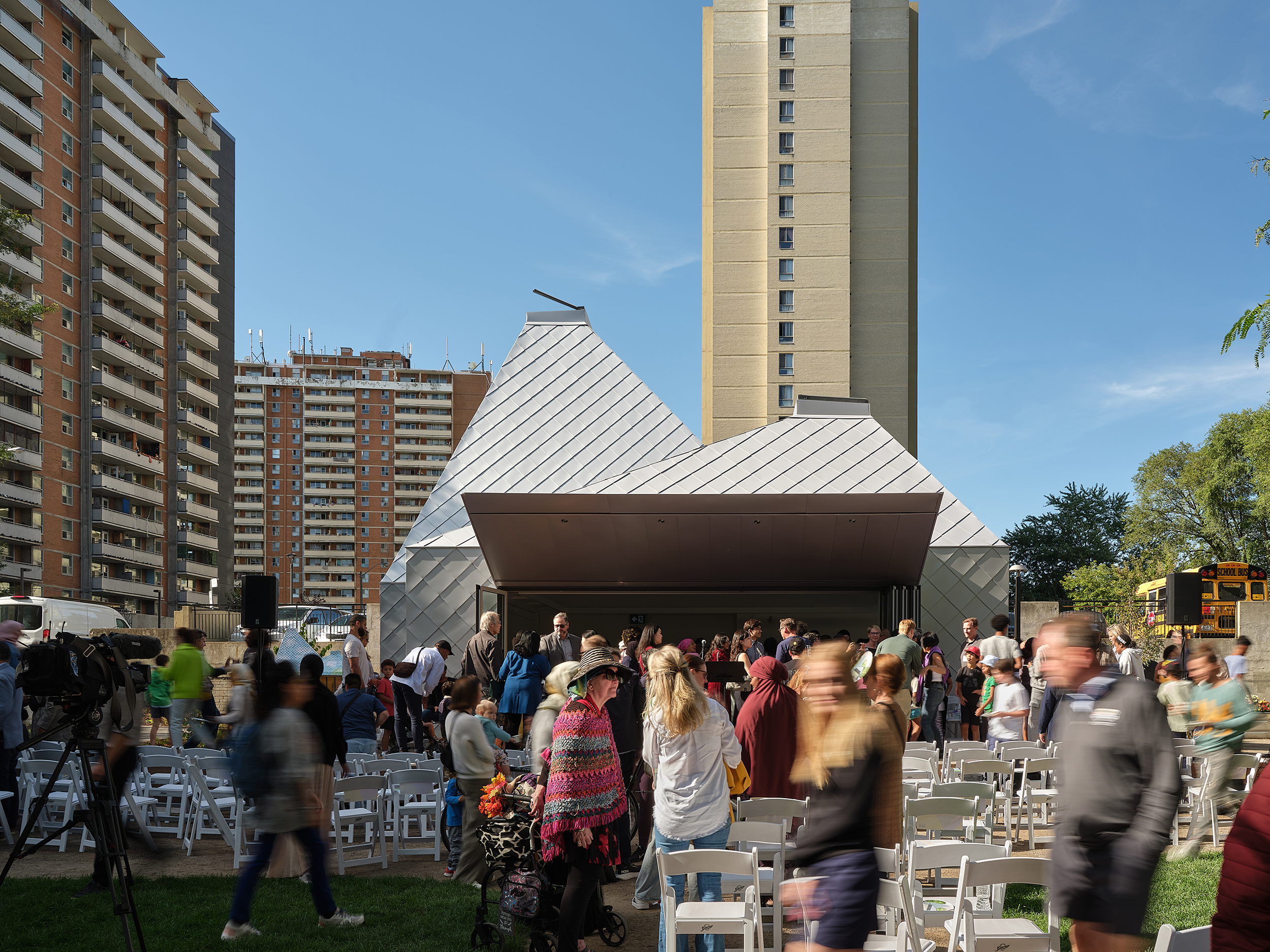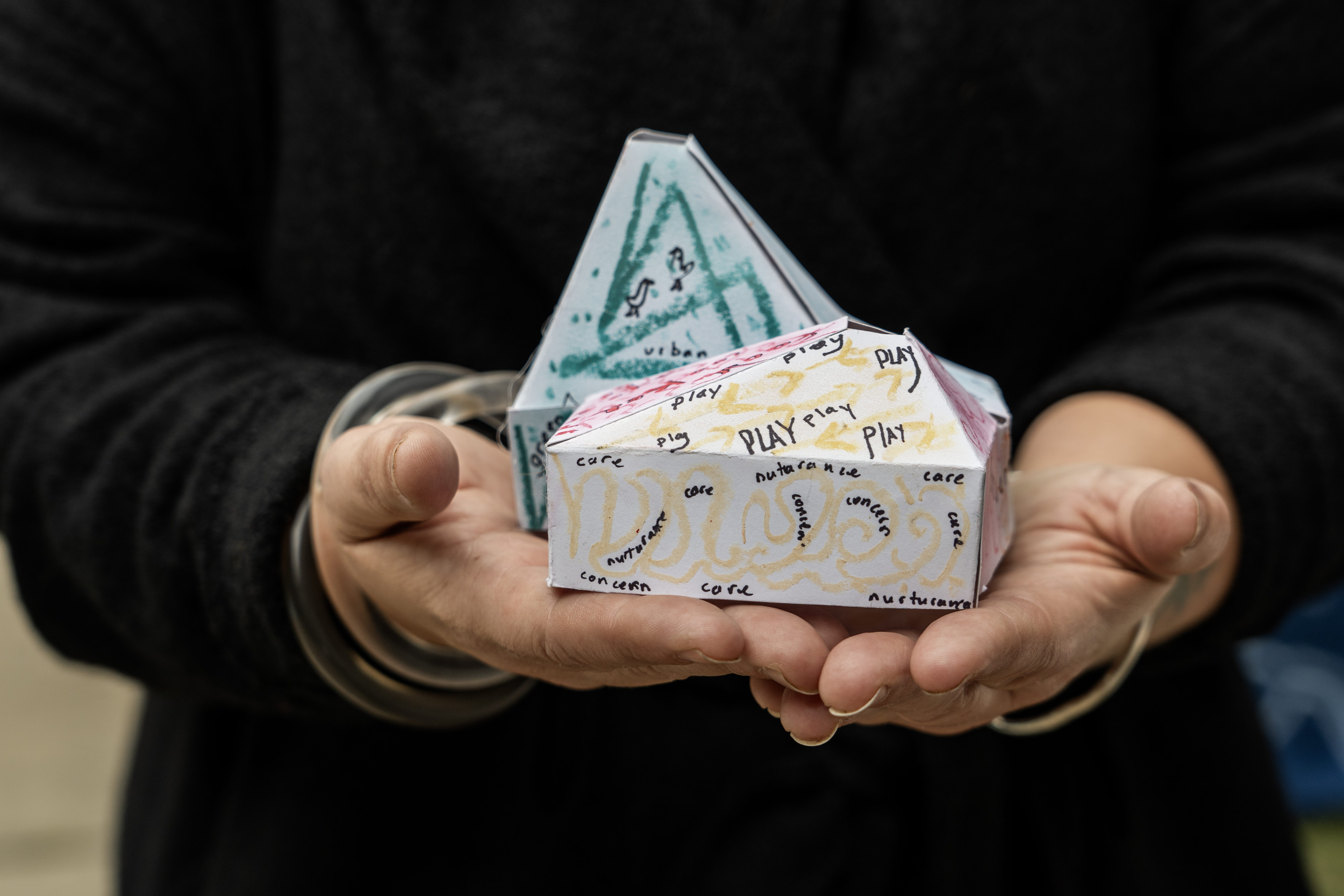Location: Toronto, Ontario
Completed: 2024
Architect: LGA Architectural Partners Ltd.
Nominated by: Lee Fairclough, MPP (Etobicoke–Lakeshore)
In a culturally diverse pocket of Etobicoke, surrounded by a dense cluster of affordable high-rise apartments, a small, shimmering pavilion has quietly become a community beacon. Born not from top-down planning, but from more than a decade of grassroots presence, the new home of Mabelle Arts reflects what happens when architecture grows with a community, rather than over it.
A Foundation in Trust
Long before there was a building or even a park, there were art supplies and conversations. Trained through Jumblies Theatre—a Toronto-based non-profit rooted in collaborative, community-driven art—Leah Houston began working in the Mabelle neighbourhood by listening, showing up, and slowly earning trust.
At first, Mabelle Arts didn’t have a home. Programming took place in borrowed spaces: vacant ground-floor apartments or the edges of an underused lawn tucked between towers. Together with local residents—many of whom were newcomer families from highly diverse backgrounds—Leah co-created programming that reflected the neighbourhood’s needs, stories, and spirit. Mabelle wasn’t so much a service, as it was a relationship.
A Building and a Park That Belongs
By the time Mabelle Arts partnered with LGA Architectural Partners, Leah had a deep understanding of the people and rhythms of the community. She knew what the organization needed to keep growing, but she also knew the value of listening. The goal wasn’t to parachute in a building, but to shape one with the community, just as they had shaped everything else.
LGA, together with Shift Landscape Architecture and Mabelle Arts, worked closely with nearly 700 residents to imagine a new future for the park—one rooted in shared use and shared authorship.
“It would’ve felt wrong not to continue Mabelle’s ethos of co-creation,” says Janna Levitt, principal at LGA.
In a neighbourhood facing ongoing development pressure, this approach helped ensure the building would deepen community ties, rather than become a harbinger of gentrification or displacement.
Even the footprint and placement of the pavilion—called The Belle—were community-informed. Set gently along the north edge of the park, it leaves most of the green space open for flexible use. A covered loggia shades its south side, while accordion-fold doors open wide onto a small stage and gathering space. In performance mode, a proscenium emerges between the open doors and the deep canopy. But just as often, the front porch becomes a space for neighbours to chat, wait, wander, or linger.
The building’s aluminum shingle cladding gleams in the sun—light, tough, and resilient. It was chosen not just for its aesthetics, but also its ability to endure years of art-making, foot traffic, and the everyday wear that comes from being deeply loved.

"The Belle" opens its doors to the stage during a busy event. Image by Doublespace Photography, courtesy of LGA Architectural Partners Ltd.
Imagined, Reimagined, and Remembered
The pavilion’s form is both memorable and uncomplicated. Two volumes—similar in footprint but not in height—join together under a pair of angular, truncated hip roofs. They lean in opposite directions, almost like a gesture frozen in motion. To some, the building looks like a fairytale house. To others, a mountain. Or a spaceship. The ambiguity is intentional, and it invites interpretation, play, and imagination.
Designed to support programming for all ages, the space pays particular attention to children. Inside, materials are modest but durable. Floors are ready for dancing, walls for painting, and tables for cooking and building. Outside, the long canopy and open sightlines give caregivers space to relax while kids explore. A bathroom with an exterior entrance provides maximum flexibility—able to support programming happening outside even when the interiors are otherwise occupied or closed. It is an architecture that aims not to separate, but to encourage overlap and layering.
Even children have noticed. Miniature paper models of “The Belle” have been cut, folded, and coloured by local kids. Lanterns and puppet versions of the iconic pavilion have been paraded around during events. These little replicas, lovingly created by participants of Mabelle Arts at their new park, symbolize the same thing: recognition for a building that feels like theirs.

One of many paper models of "The Belle" made by the community. Image by Katrin Faridani.
Continuation, Not Transformation
It’s tempting to see Mabelle Park and the Belle as a finished project. But for the people it serves, it’s just the next chapter in a story that’s still unfolding. The building didn’t arrive to transform the neighbourhood—it arrived because of it.
In that way, it isn’t a monument to change. It’s a reflection of what has always been here: joy, care, resilience, and a quiet insistence that everyone deserves beauty and a place to belong.
This post is part of the OAA’s Queen’s Park Picks 2025 series, where Ontario’s Members of Provincial Parliament (MPPs) were encouraged to nominate a building in their riding for a chance to learn more about it. This year, MPPs were asked to consider various typologies related to “reshaping communities” when making their suggestion, tying into the 2025 OAA Conference theme. Check out the rest of the series to learn more about great buildings across the province.